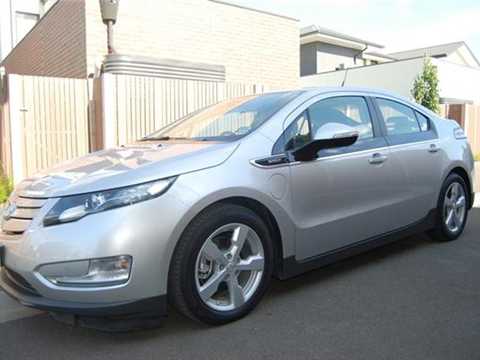There’s been a lot of noise about BMW’s i3 since its launch in November. A bit of a contradiction given the all-electric hatchbacks’ virtual silent operation.
Oh, there’s the Mitsubishi i-MiEV, Nissan Leaf and even – if you live at Sanctuary Cove or on Hamilton Island – glammed-up golf buggies, but the BMW i3 and Tesla Model S are the first purpose-designed electric vehicles to be sold in Australia. And with the Tesla priced at $96,208, the $63,900 i3 is our best bet so far for a premium electric vehicle.
Mind you $63K is some coin for what is ostensibly a compact hatchback. We just don’t get the lethargy of authorities in Australia who stubbornly refuse to offer any financial incentives for electric car buyers like those offered in North America and Europe.
It seems we’re not ‘The Lucky Country’ any more. C’mon you bureaucrats, it’s not that hard – the BMW i3 is here now, spearheading BMW’s green ‘i’ sub-brand, and surely the time is well overdue for us to get on the same page as progressive nations in the northern hemisphere.
BMW i3 Overview
Make no mistake, with the i3, BMW’s brilliant technology has delivered an electric hatchback which embodies the very best automotive technology as it exists today – a lot of which can be traced back to F1 Grand Prix racing. This clever compact hatchback ushers-in the future of green motoring from Europe.
The i3 runs a carbon-fibre reinforced plastic passenger cell and body in which the 360-volt lithium ion battery pack is mounted low and further protected as part of the aluminium chassis. The carbon-fibre is sourced from a plant in North America which uses only naturally renewable sources for its energy and materials used inside the i3 are mostly sourced from renewable products like eucalyptus (the world’s fastest-growing timber) and wool.
BMW calls the i3 a ‘purpose-built premium electric car’. Bottom line - it is a compact hatchback (but great design mean there’s room for four adults in comfort and 230l-1100l of luggage space) with head-turning futuristic looks including clever rear-opening ‘coach’ rear doors and a glass tailgate.
Of course a BMW is a BMW and the electric-propelled versions are no different from the regular model range when it comes to standard premium equipment. So you’ll find satellite navigation, parking assistant, a rear-view camera and DAB+ audio just for starters.
For www.carshowroom.com.au BMW provided the entry-level pure-electric i3 priced at $63,900. An extra $6,000 will secure you a version with a 650cc two-cylinder petrol ‘range-extender’ engine for electricity supply – the engine from a BMW Motorad scooter.
The crucial numbers for the BMW i3 are, for the version we tested, exhaust emissions and fuel consumption which are both zero and, for the range-extender version, fuel consumption is 0.6l/100kms and exhaust emissions rate at 13g/km.
Of course range between re-charges is the often-debated point for electric cars. BMW says the pure-electric i3 in ‘Comfort’ mode offers a range up to 160kms from a single charge (growing to nearly 200kms in ‘Eco Pro+’ mode). It was the height of summer when we tested the i3 and, with the air-con working hard, our range was around 110kms.
Here’s the thing - considering your average week, when was the last time you drove more than 100kms in a day?
Or with the range-extender version of the i3, BMW says we’re looking at a range of up to 300kms.
BMW i3 Engine
Well, ‘under the hood’ isn’t relevant here as the BMW i3’s eight-module, 360-volt Lithium-ion battery pack is mounted under the rear seat. The batteries power a 125kW/250Nm hybrid synchronous electric motor located under the cargo area and driving the rear wheels via a single-speed direct-drive system.
According to the Federal Government’s ‘Green Vehicle Guide’, energy consumption for the pure electric BMW i3we tested is rated at 129Wh/km. That makes the i3 the most energy-efficient electric car in Australia.
Of course, to be fair, the likes of the Nissan leaf and Mitsubishi i-MiEV are basically conventional passenger cars converted to electric (well the LEAF was created as an electric car but uses conventional materials and manufacturing processes). The BMW i3 uses carbon fibre reinforced plastic and aluminium to keep its weight down to 1195kgs (1315kgs with range extender).
Regenerative braking is strong and immediately obvious when you drive the BMW i3. This can provide up to 50kW of energy back to the battery pack and extend the range between recharges by up 20 per-cent.
BMW i3 The Interior
The i3 looks nothing like a BMW as we know them on the inside. Oh, there is some familiarity like the iDrive and audio controls, but everything else is a custom design for this car.
Everywhere you look are unusual materials reflecting the sustainable nature of the i3 – for example seats are trimmed in wool and leather (the latter tanned free of chemicals using olive tree leafs). The good-looking timber highlights come from eucalyptus which is the world’s fastest-regenerating timber and even the door panels are made from the kenaf plant which is part of the cotton family.
You sit high, like an SUV and those in the rear (a bench with two seats) enter via those innovative rear-opening ‘coach’ doors. To open the rear doors, the fronts must be opened first and co-ordinating this takes some familiarity.
The driver gets a two-spoke steering wheel and 5.5-inch digital instrument panel (the largest display on that panel is the curved bar graph which shows energy consumption/regeneration). Gear selection and engine start/stop are via a rotary dial and push-button to the right of the steering wheel.
To the left is the familiar BMW audio system controls and free-standing 10.3-inch screen for the satellite navigation and reversing camera image. And the iDrive controller is where you expect on the centre console.
The BMW i3 is surprisingly spacious for all occupants. Those in the rear enjoy remarkable leg-room for a compact hatchback. The rear seat split-folds 50:50 and cargo capacity is generous at 260-litres with the rear seat in-place or 1110-litres when folded.
BMW i3 Exterior & Styling
A compact hatchback it may be but there’s a lot going on in the styling of the BMW i3. From the multiple curves for the side window lines to the two-tone paint scheme, glass rear hatch and stubby front-end this is a BMW the likes of which we’ve never seen.
Then there are those ‘coach’ rear doors. Able to be accommodated because the strength of the carbon-fibre passenger cell doesn’t require B-pillars for rigidity, there’s no doubt they do provide easier egress for those in the rear.
Up-front there is the hallmark BMW ‘kidney’ grille – but a just for styling as there is no air inlet. And the rear sees the ‘U’-shaped tail-lights which are now part of the BMW style book.
BMW i3 On The Road
So how does the BMW i3 stack-up as a daily driver? Are electric cars really functional for Australian families?
‘Great’ and ‘Yes’ are the answers to those questions. We know because during the week the BMW i3 was in the garage here at www.carshowroom.com.au we treated it just like any other car.
OK we live in the suburbs and our daily working week drive is around 50kms so we acknowledge long distance commuters or those in the bush might need the range extender version. For us, we treated the BMW i3 like our mobile telephones and laptops – we plugged it in (cable stored where the bonnet would normally be) each night when we arrived home.
Over our high-speed mountain roads test loop we must say the BMW i3 performed better than it did in the twists and curves found on the roads around Canberra where BMW staged the national press launch. Our test roads were smoother and hence we found the i3 less jittery.
The tyres on those nicely-styled 19-inch alloy wheels are narrow for enhanced aerodynamics but grip levels are high (a smidge of understeer when you explore the limits) and the i3 exhibits typical European firmness in the suspension calibration. Steering is reminiscent of that other BMW brand Mini in its directness (just 2.5 turns lock-to-lock).
Like all electric cars with their single speed direct drive systems, acceleration is very brisk indeed (albeit in uncanny silence) – zero to 100km/h for the BMW i3 we tested rated at 7.2 seconds. And even in the mid-range (say when overtaking on a freeway) there’s plenty of punch and it’s delivered immediately.
Around town the directness and maneuverability of the BMW i3 were standout attributes. A diminutive 9.86-metres for the turning circle made easy work of CBD parking.
Bottom line: for driving dynamics, performance, maneuverability and convenience there absolutely no reason why you would not buy the BMW i3.
BMW i3 Issues
OK the ride and handling is different from say the M3, but the fact is this isn’t an ‘M’ badged high performance BMW rocketship – the i3 is the first vehicle from BMW’s ‘i’ brand which as we know is all about sustainability and minimized fuel consumption and emissions.
BMW i3 Verdict
BMW says the i3 will change the perceptions of electric vehicles. Yep, we go along with that.
Put all the rhetoric aside and the fact is the vast majority of us could drive a vehicle like this as our everyday car and the world will be a better place for it. We do acknowledge many Australian families will still need say the BMW X5 as their second car for those times (vacation road trips for example) when you need the extra space and plan to cover massive distances.
But BMW has delivered a game-changer here. Zero emissions, great dynamics and BMW style premium luxury – no comments about golf buggies apply.
BMW i3 The Competition
The $63,900 BMW i3 ($69,900 with range extender) really has no directly comparable rivals. It is the only premium compact hatchback electric car.
Nissan’s excellent Leaf is priced at $39,990 and the Tesla Model S starts at $96,208.






































